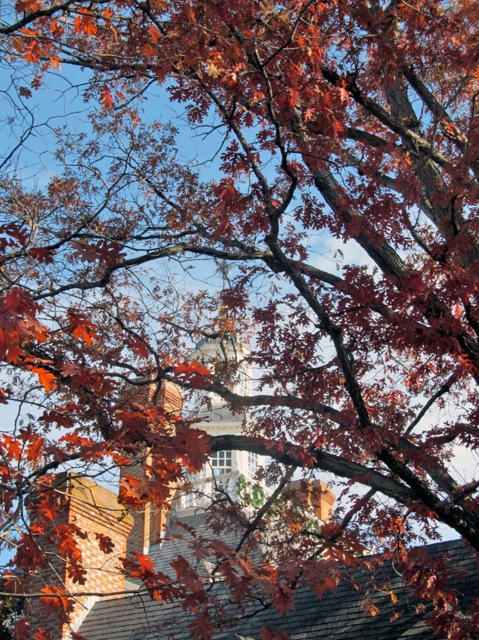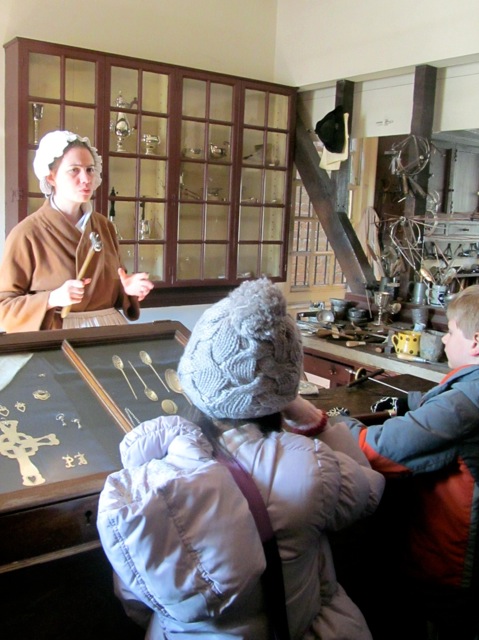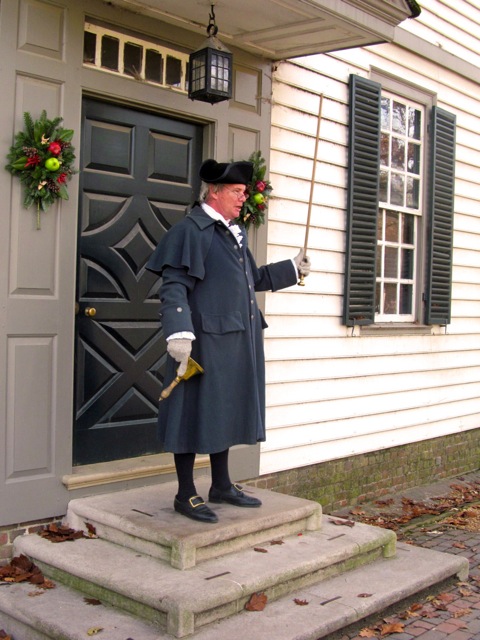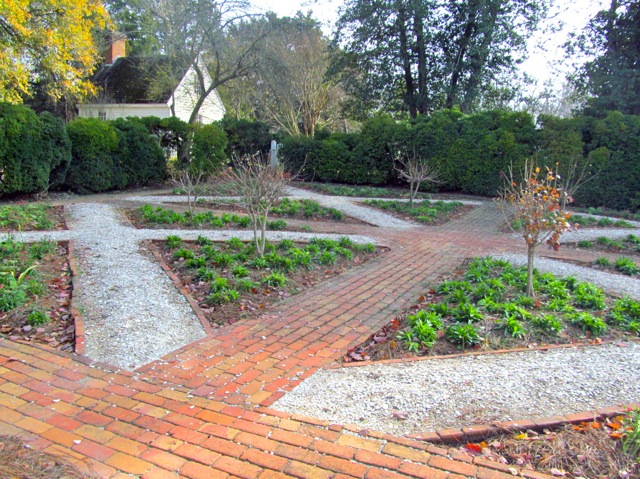Greathall Productions, Inc. presents...

Introduction
Jim's Studio
Photos from Our Travels to Literary and Historical Sites
that Relate to Greathall Recordings in:
The United States: VirginiaKentucky
California
Oregon
IrelandItaly
Germany
Jordan
Singapore
New ZealandEngland
Spain
Japan
France
How to Build a Castle (France, 2013)
Photos from Here & ThereThere are 6 pages of pictures of Virginia. This is page 5.
1 - Thomas Jefferson's Monticello and Poplar Forest
2 - Red Hill, The Patrick Henry National Memorial
3 - Appomattox Court House Historical National Park
4- Mount Vernon, Home of George Washington
5 - Colonial Williamsburg
6 - Montpelier, James Madison's Home
Colonial Williamsburg, Virginia
Colonial Williamsburg, VA, is a magical place in which modern visitors can experience life in colonial times. The Royal Governor's Palace reflects the power and grandeur the governors wished to convey to the colonists. Visiting Colonial Williamsburg today sets you down in the capitol of Virginia before, and during, the American Revolution. This fascinating place is the setting for many of the stories on our recordings, “Thomas Jefferson’s America,” and “George Washington: First in the Hearts of His Countrymen.” Leaders who lived and worked here as members of the House of Burgesses, the Virginia legislature of the time, included Washington, Jefferson, James Madison, Patrick Henry and other notables.
Governor's Palace, Williamsburg, VA. The royal coat of arms above the door, shining in gold, represents the United Kingdom: the English lion is on the left; the Scottish unicorn on the right.
A velvet-walled chamber in the Governor's Palace, on the way to the grand ball room. This gentleman was kind enough to guide us through "while the Royal Governor and his family are up the street at church for the baptism of the newest addition to their family." At its best, Williamsburg takes us right back into the events and circumstances of the time.
This boxwood garden behind the Governor's Palace was the scene of many a leisurely stroll. Nearby is a much higher boxwood maze, in which it would be easy to get lost for a time.
Our young friend visiting from Singapore finds the boxwood garden a child-sized place for a walk.
Our visitor from Singapore playing tag with Jim in the boxwood garden. Notice Jim's lead. He is used to playing tag, I guess.
The spire of the Governor's Palace, seen through the last, bright maple leaves of late autumn.
The Governor's Palace, as seen from Duke of Gloucester Street, the main avenue of Colonial Williamsburg. Even the location on the far end of a long, green lawn, was intended to increase ones awe upon approaching the place.
Jim outside the Bruton Parish Church on Duke of Gloucester Street, the main avenue of Colonial Williamsburg. The churchyard holds the graves of many Revolutionary and Civil War figures, including the graves of two children from Martha Custis's first marriage. Later, as a young widow, she would meet and marry George Washington, who also worshipped here.
The Bruton Parish Church in Williamsburg is just steps from the Governor's Palace, symbolizing the Crown's affiliation with the Anglican Church. These particular pews were those used by George Washington and James Monroe. The church is still in use, with a large, active congregation, though it is no longer affiliated with the government, of course.
Sermons in Bruton Parish Church were heard by many of the United States' greatest leaders during the colonial and revolutionary eras. The place still fills up on Sundays with regular congregants and visitors.
Mr. Monroe's pew, in which the future fifth President of the United States worshipped while living in Williamsburg during sessions of the legislature.
A leisurely trip around town, anyone? Of course, in colonial days, this elegant coach would have carried the wealthy and powerful, not the average tourist.
The Redcoats are coming! In earlier colonial days, of course, that would have been reassuring.
A British soldier of colonial days marches before the local Army Commander.
A British officer addresses a crowd of "colonists," attempting to rouse their enthusiasm for the loyalist cause and against these rebellious rabble rousers who have been causing all the trouble lately. In the background is the Capitol Building, in which the two legislative houses, the supreme court and the governor's office functioned. For well over a century, this was the seat of power in Virginia, until the capitol moved inland to Richmond to increase the distance between revolutionary leaders and the powerful British Navy off the coast.
Jim listens to our guide in the entry hall of the Capitol Building in Williamsburg, VA. Weapons on the wall were used periodically, as in the French and Indian War. Their presence in the entry to the Capitol was meant to impress visitors with the power and military might of the British government. In this colonial era atmosphere, Jim is appropriately dressed in a red coat. He would have changed it for some other color once "the trouble" began.
A Williamsburg resident crosses in front of the Capitol Building's side gate. Perhaps she was on her way to the nearby market place, or carrying refreshments in her basket for a sick friend living one of the side streets near the Capitol.
An inn at which members of the House of Burgesses, Virginia's popular legislative house, might have stayed during working sessions. Here you might have shared a table and conversation with the likes of Patrick Henry, Thomas Jefferson, George Mason or George Washington.
Minstrel Robin took song requests during a meal at the King's Arms Tavern, where Washington, Jefferson and Co. might have been dining at the next table from ours.
A strolling master musician plays the pochet, French for "small pocket," a portable violin. It may have been on such an instrument that Thomas Jefferson was playing when he was approached by a red-headed stranger requesting him to repeat a song. The stranger was Patrick Henry! As the common phrase goes, "the rest is history." (The story of their relationship is part of our recording, "Thomas Jefferson's America.")
Our musician, from Ye Olde Country (in this case, Scotland,) took time from his playing at the King's Arms Tavern to discuss the pochet, or pocket violin with our party.
Listening to music while, in the background, dining and conversation continue. Here our musician has a mini-violin.
Jim savors the music of the musician sharing popular songs of the colonial era at the King's Arms Tavern, where we ate traditional foods. (They have the best peanut soup ever, and fabulous prime rib. Yumm.)
A colonial silversmith explains traditional methods for smelting, shaping and smoothing silver and other metals. Paul Revere of Boston was perhaps the most famous silversmith of the colonial era, and the pieces he produced are still highly prized today.
In a town the size of Colonial Williamsburg, the local physician also was the apothecary, or druggist. Here, his "assistant" talks of herbs and other traditional cures for a variety of illnesses or injuries.
Here is Williamsburg's shoemaker. I don't see any elves in the background, though. Do you? For a time, there were no "left" and "right" shoes, though here the shoemaker is wearing some. Instead, there were shoes with long points in the middle, and one wore them interchangeably on either foot.
The bell rings to get our attention and a crowd gathers to hear this gentleman's public announcement of an upcoming auction.
Williamsburg: a decorative garden is also a small vegetable and fruit garden. In the days before supermarkets, one maximized the use of space for essential purposes.
Our visitors examine a traditional toy. A ball hangs from a string, the other end of which is attached to what looks like a wooden ice cream cone in this photo. The goal is to flip the ball upward and catch it in the cup. It takes practice, or great luck, to succeed. Jim's father once made him one of these toys.
A peaceful pasture. The side streets and back yards of Colonial Williamsburg yield many such scenes.
Lambs in a pastoral scene in Williamsburg remind us that this was home for families of the colonial and revolutionary times.
Click here to go to the previous page...
There are 5 pages of pictures of Virginia. This is page 5.
Introduction
Jim's Studio
Photos from Our Travels to Literary and Historical Sites
that Relate to Greathall Recordings in:
The United States: VirginiaKentucky
California
Oregon
IrelandItaly
Germany
Jordan
Singapore
New ZealandEngland
Spain
Japan
France
How to Build a Castle (France, 2013)
Photos from Here & There
About Jim Weiss | Storytelling Recordings
A Letter from Jim & Randy | Jim's Photo Album
Timeline of Recordings | Travel Calendar | Book a Live Performance
| Jim Writes...
Jim Weiss
Post Office Box 5061
Charlottesville, Virginia 22905-5061
(800) 477-6234 (434) 296-4490 FAX































